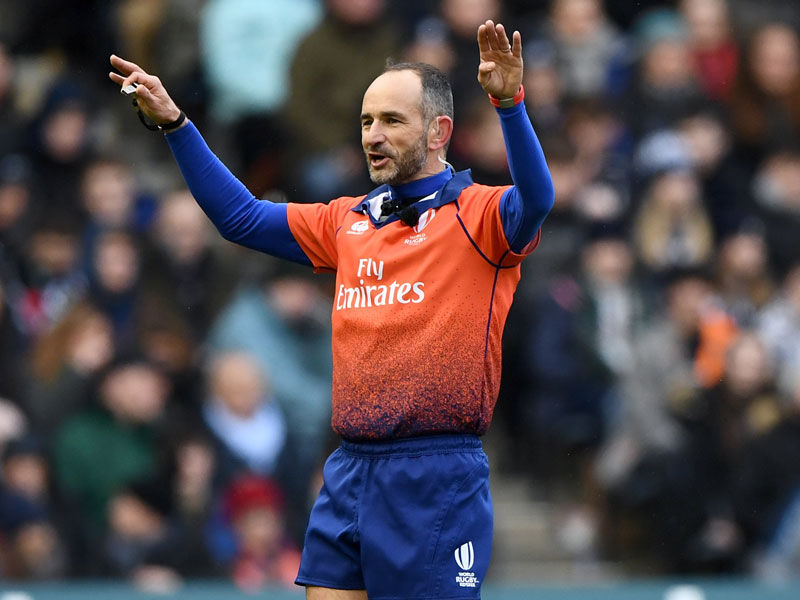Is that really the law?
- harrydieleeu
- Jul 15, 2021
- 7 min read
Watching rugby the last few weeks I started believing my menopause is really here. Mood swings from elation to frustration. The reason for my blood pressure going higher than a NZ vs Tonga score is the current lawlessness of professional players within the framework of a highly governed environment. Confused? Let’s just pretend I have carte blanche for one day to change a few laws, as well as the interpretation of existing laws. Here goes…….
My approach is still intent on making rugby a fair contest and speeding up the game. But I would like to make sure teams like NZ will not keep on finding loopholes and exploit the lack of clarity on certain rules. Although in no particular order, as an ancient number nine, I will start with the two issues making the biggest contribution to my frustration levels.
Is the ball in or out?
If only I had a third hand, then I could hold my tranquility drink in one hand, the remote in the other and a stopwatch in the third. I will then prove to you that we probably lose up to ten minutes per match while scrum-halves have their hands on the ball, check their hair on the big screen, re-tie their boot laces, move one or two heavy units around for protection before they roll the ball to a player already under pressure, or kick a box kick that will inevitably hand over possession, or land within the ten meter circle, or go out on the full. If I could change the rules to a much easier one: If the hand is on the ball, it is out. If it is not yet out, it is a hands in the ruck- penalty.
How crooked is still straight?
Come on referees, the rule is still in the rulebook. Start penalising these scrum-halves that leave the responsibility for hooking the ball to the locks. Two clear rules governing this.
a. The ball needs to go into the scrum under the line formed by opposing players scrumming down.
b. The hooker must hook the ball.
This is not difficult.
Are scrums governed by rules or policed by educated guesses?
Let’s face it, very few ex- forwards make it to top level referees. Often referees have never played the game at all but have a love for the sport. Or they are ex backline players who have only ever seen scrums from 15 meters away. Or ex scrum halves still suffering from the red mist that plagued them during their playing days. So, what can be done?
a. Design jerseys for props with designated binding areas. Make it lime green or whatever, and even put a recess in there for easier binding.
b. Employ ex- props to police the scrums. Where technology is available, they can sit with the TMO. Or else they can sprint (or lumber) to scrums and make the calls for the referee.
Did you know you are in the team to scrum?
If a prop fails to keep a scrum up for 3 consecutive attempts during the same scrum, stop wasting time with coaching, begging or threatening. Show him a pink card and sub him for 10 minutes. Referee prerogative only.
When is advantage over?
There is far too much interpretation here. Some referees allow one kick and call advantage over. Others let the game run for 5 or more phases all over the field and still call no advantage! My rules for advantage are simple:
a. The minute the referee calls advantage, and you want the advantage, put the ball down.
b. If the referee calls advantage, and you pass or kick the ball, you have used your advantage.
c. Some innovation to speed up the game won’t hurt. If a referee calls penalty advantage, you are allowed to kick the ball out on the full from anywhere on the field, and the ensuing line out will be your ball.
d. If the attacking team gets a penalty in the red zone, they have 4 choices:
· Kick for poles.
· Tap and play.
· Scrum.
· Line out on 5m line. No kick for touch required.
Is it a ruck or a lottery?

Here I would look at a couple of rule changes, as well as tighten up on a few interpretations.
a. Only players physically attacking the ball or attempting to counter- ruck are allowed to be cleaned. Cleaning has a specific definition, which is to drive an opponent of the ball with your shoulder. Any “cleaning” beyond the ball is obstruction, should be penalised. Any player neck rolled, or man handled out of a ruck is being tackled without the ball. Penalty.
b. Any player standing on hands and knees beyond the ball, staring into the camera like a Miami Dolphins defensive tackler is illegally taking up space and should be penalised.
c. Pillars belong in a Greek temple. You should either be bound to the ruck or fall back behind the off- side line. Any movement to protect the kicker in front of the kicker is obstruction.
The biggest surprise of all is that all of these things are covered by rules in other facets of play, but ignored during rucks. I wish of course I could bring back legal rucking. I remember this conversation between the referee and I clearly: “Ref- check these stud marks on my back!” Referee(unsympathetic) “Sorry scrummy, you were lying on the wrong side of the ruck, I cannot protect you.” Sometimes the good old days were really the good old days………
Is it a slap or not?
When a team is on the attack, and you display no “clear and obvious intent” to catch the ball, you are penalised, and if the referee is in a bad mood, carded. So why is a slap backwards allowed? It is still a cowardly way of preventing a try.
Excuse me sir- is that five meters?
During a standard lineout, a ball needs to travel 5 meters. Even if the player that catches it is behind the line, but catches the ball in the five-meter zone, it is a free kick. Easy rule, no interpretation. So- if someone attempts a quick throw in, why are opposing players allowed to stare him down toe to toe, or jump up and down like a Virgin fitness instructor? Preventing the ball to get into play from within the 5 meter line should be penalised.
Forward pass or off- sides?
If you miss a catch, and the ball spills forward, anyone in your team playing that ball in front of you is deemed to be off sides, and penalised. If you throw a “ clear and obvious” forward pass, and a team member catches the ball in front of you he is……? NOT offsides. The one is penalised, the other one incurs a scrum. Just asking- is it not the same thing?
Is the whole team guilty?

a. A red card is issued to a player after a serious infringement, and 99% of the time due to foul play. I do not believe the team should be penalised in this case. A red card should carry an immediate and automatic two match suspension, pending an appeal. But for heavens’ sake, allow that player to be subbed after 10 minutes and let’s get on with a fair contest.
b. Likewise, if a team is on a warning for continuous infringements, do not penalise the hapless next player who happens to stray off- sides. Captain- I have asked you to control the team- go and take a breather.
Let’s check the numbers please.
In days gone by, line- outs were uncomplicated. Both teams join the line, defending scrummy goes: “ 1, 2, 3, 4, 5, 6- 6 in boys. And two will fall back. No mess no fuss. Today there is a conference, some water drinking and a general discussion. 5 minutes later the weary troops drag themselves to the line- out, while the prop runs up to the hooker and whisper sweet nothings in his ear. All the while the referee shouts, begs or threatens to find out how many will eventually make it to the line- out. WHY!!?? In my view, it is fairly simple. If, by the time you reach the line- out, and you have not clearly informed the other team and the referee about your numbers, the opposing team is no longer obliged to match your numbers. Problem solved.
Is it really high Mr. Ref?
Perhaps the most contentious of all my gripes, and most certainly difficult to find a solution for. But in cricket they have technology that can predict whether a ball was going to hit the wickets or not. Technically, if we know the height of a player in upright position, a simple application will tell you what the tacklers intent was. If you aim for his waist, and all of a sudden his face is in the way, so what? Your intent was to execute a legal tackle. And yes, there is an existing definition of what is high or not. Ducking into a tackle will soon become an art, intended to rob opposing teams of players.
Can someone measure the velocity please?

When a person is tackled intentionally in the air, it is a penalty, and should have a standard outcome. What does it really matter then whether the player landed on his head or shoulder? Some people are just better gymnasts than others. To illustrate my point, we will look at handbags at five meters. Low and behold, a punch is thrown. Now the decision goes as follows:
· Glancing blow to the face- penalty
· Is the player dazed? Yellow card.
· Is he lights- out- red card.
That sounds absurd, doesn’t it? But that is how we handle high tackles. Did I mention a simple solution? No jumping when you catch the ball. We will see a few great hits, but no more frustrating red cards.
Lastly, unless we change the way we keep statistics, very soon hookers on all levels will be the top try scorers in rugby, for ever and a day. Until recently, scoring a brace of tries was considered great, while a hat- trick was outstanding. In the past month in representative rugby, on no less than 5 occasions hookers managed to score 4 tries or more. I propose that all tries scored by a player at the back of and attached to seven other players committing gang obstruction in front of him should be counted as so called team tries and not individual tries.
Rhetorically I need to ask- am I the only fan that is frustrated by all this? Or are there others out there who have also wished to be in charge of world referees for one day only? Wishful thinking perhaps, but it is still a great tonic to see your feelings spill out in words like this. So next time you want to throw a Johnny Walker glass through your HD screen- rather just sit back, sigh and wish that you could be in charge for one day only……….












Well done, excellent from the 1st word to the End.
You sure know your Rugby.
Marietjie